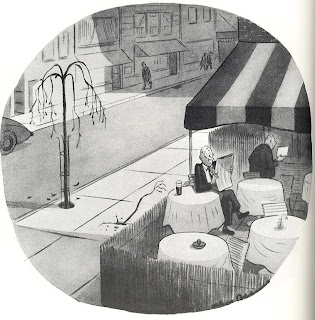
I just got it.
It took me 45 years to really see this cartoon. While looking for a different Addams cartoon a couple days ago, I happened across this one, and at last! the light went on.
I was about (?) 8 or 9? when I first saw it. In addition to the Peanuts books, I was raised in a home stocked with a library's worth of Charles Addams, possibly a peculiar thing to appeal so to a little girl, but I pored over them for hours.
At that time all I saw was the spectral "hand" of the tree root. I even noticed it was reaching for the glass, but to me it still looked menacing. It's gonna pick his pocket too, I bet! That trapped, dehydrated, desperate little tree over on the left? It barely registered, and 45 years of looking at it numerous times didn't change that.
Possibly, this demonstrates a simple rule of childhood, like: the way you perceive something when you're 8 gets locked in, and you see it that way forever because you see your mind's interpretation instead of the real object.
But there's another factor at work here and that's the ADD thing. My first take on anything I see, read, hear, is just that narrow. I can't handle much info, so I zero in on key elements and let them define my response. Often very inaccurately.
Last time I wrote about ADD Life, some interesting responses came up in the comments, mostly about remembering things, retrieving stored information out of what Mike likened to a bank of file drawers in the brain. Diane Harrington's term "attention difference" brought a grin to my face because it's so like the "differently focused" label I concocted for myself.
There are also encounters with the new, and with the unexpected, to consider. I can be extremely focused, and that's the word: I focus in the extreme. I narrow my mental aperture to a pinhole, find a key element and screen out the rest. In searching for something that's usually in a predictable spot, I look in that spot. If it's not there then a normal person opens the aperture a notch and widens the search. I do too, but only after
SYSTEM FAILURE/SHUTDOWN/REBOOT. And a few $#%* -type words.
In fairness, most people use mental shortcuts, especially people whose day involves sifting through minutiae. I've noticed, with my teeth gritted, that doctors are real big on this. You can say, "I haven't walked in the woods for a month and this rash appeared yesterday," and they listen for key words: "walked in woods"; "rash." Then ka-ching! (in more ways than one) a poison ivy diagnosis pops out, the one-month gap between the walk and the symptoms unheard.
I go further and simplify even the already-simple:
 ADD QUIZ time!
ADD QUIZ time!Can you spot the exercise ball in this picture?
I couldn't. Really. It's usually on the floor in front of the cedar chest. I walked in, looked there, walked out and asked Larry, "Where'd the exercise ball go?"
Bless him, he resists the nearly irresistible "Are you blind?!" kind of response. He's had 12 years to get used to this stuff, and just tells me, if he knows the answer. He's a kind and supportive man. Who values his life.
Meanwhile, my life's work is to rethink. Re-look. Reread, re-listen, reassess nearly everything, for the details, the nuance, the broader picture that I nearly always miss the first time. And accept the fact that I will never cover more than a third-to-a-half of the territory others cover, because my gears turn so bloody slow.
But lest you think that I fail to see the flexibility advantages that come with learning slowly, I have encountered the upside.
One day in library school we got a classroom exercise. Prof handed out 4 sheets of paper to each of us. On the top sheet were numbers (1-20, if I recall correctly) scattered randomly, like a kids' connect-the-dots puzzle. He took out a stopwatch. Our task was to connect the numbers in order.
We all fumbled through it. Then we did the 2nd sheet. It was identical to the first, so, having done it once, most people got faster. By now I was coming in last. The third sheet was also identical to the first 2. The rest of the class whipped through it and put down their pencils, while I continued to fumble.
The prof took 2 dollars out of his wallet and slapped them onto the table. "OK, the first person to finish the last sheet wins the money," he said.
[cackle] Yep, sheet 4 was a whole different pattern. I finished first and won the 2 bucks. I had less to unlearn.
He suggested that most people would buy the class a dozen doughnuts and share the winnings. No one in that group really needed doughnuts, and he for sure didn't. On my all-frozen-dinner grad student budget, it would buy me two -- two! -- "Mr. P's" frozen pizzas (They fit in my toaster oven), so in another demonstration of my decent IQ, I kept the money.





